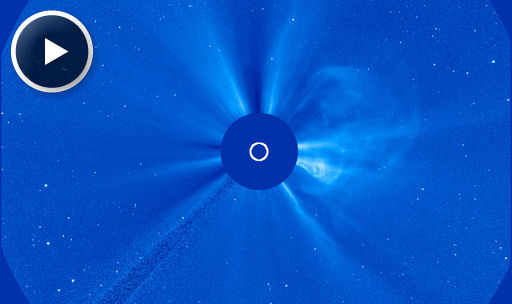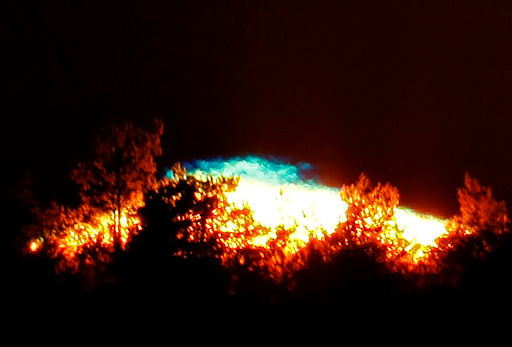![]()
MARS AT OPPOSITION: Mars is approaching opposition. On March 3-5, the Red Planet will be up all night long, opposite the sun and as close to Earth as it will get in 2012. Mars shines overhead at midnight 6 times brighter than a 1st magnitude star and looks great through a backyard telescope. [sky map] [photos: #0, #1, #2, #3, #4]
FARSIDE EXPLOSIONS: The Earthside of the sun is quiet, but the other side is not. On Feb. 29th, a farside sunspot erupted multiple times, hurling three CMEs over the sun's western limb. The Solar and Heliospheric Observatory recorded the expanding clouds:
The odds of more farside eruptions today seem high. The odds of Earthside eruptions, however, are just the opposite. NOAA forecasters say the chances of M- and X-class solar flares are no more than 1%. Solar flare alerts: text, phone.
BLUE FLASH: We've all heard of the green flash, the fleeting emerald light that sometimes appears just above the setting sun. Once thought to be a fable, the green flash was popularized by Jules Verne in his 1882 novel "Le Rayon Vert" (The Green Ray). Now it is generally known to be real.
But what of the even rarer blue flash? Turns out, that's real too. Peter Rosén photographed one from Stockholm, Sweden, on Feb. 29th:
"I was shooting the sunset when, suddenly, just as the sun was about to disappear behind the treetops, there was a mighty blue flash," says Rosén.
Blues flashes are formed in the same way as green flashes: a mirage magnifies tiny differences in the atmospheric refraction of red, green and blue light. Blue flashes are generally harder to see than green flashes, because blue flashes blend into the surrounding blue sky. When the air is exceptionally clear, however, the blue flash emerges.
Verne described the green flash as something "which no artist could ever obtain on his palette, a green of which neither the varied tints of vegetation nor the shades of the most limpid sea could ever produce the like! If there is a green in Paradise, it cannot be but of this shade, which most surely is the true green of Hope."
Ditto the blue.

![]()
Solar wind
speed: 471.1 km/sec
density: 1.2 protons/cm3
explanation | more data
Updated: Today at 1615 UT
![]()
X-ray Solar Flares
6-hr max: C3 1526 UT Mar01
24-hr: C3 1526 UT Mar01
explanation | more data
Updated: Today at: 1600 UT
![]()
![]()
![]()
Daily Sun: 01 Mar 12
![]()
![]()
Sunspot 1423 poses no threat for strong flares. Credit: SDO/HMI
![]()
![]()
![]()
Sunspot number: 22
What is the sunspot number?
Updated 29 Feb 2012
Spotless Days
Current Stretch: 0 days
2012 total: 0 days (0%)
2011 total: 2 days (<1%)
2010 total: 51 days (14%)
2009 total: 260 days (71%)
Since 2004: 821 days
Typical Solar Min: 486 days
Updated 29 Feb 2012
The Radio Sun
10.7 cm flux: 102 sfu
explanation | more data
Updated 29 Feb 2012
![]()
![]()
![]()
Current Auroral Oval:
![]()
Switch to: Europe, USA, New Zealand, Antarctica
Credit: NOAA/POES
![]()
![]()
![]()
Planetary K-index
Now: Kp= 3 quiet
24-hr max: Kp= 3 quiet
explanation | more data
![]()
Interplanetary Mag. Field
Btotal: 5.6 nT
Bz: 3.8 nT south
explanation | more data
Updated: Today at 1618 UT
![]()
![]()
![]()
Coronal Holes: 01 Mar 12
![]()
![]()
A solar wind stream flowing from this minor coronal hole could reach Earth on March 4-5. Credit: SDO/AIA.






